
Darwin's Predictions
Ahead of his time is putting it moderately for Charles Darwin.
The father of evolution had conjectures that were only proved,
or greatly substantiated, decades after his death in 1882, in
some cases not until recently. Today, evidence that
unequivocally supports his theory of evolution by natural
selection, as well as other surmises he had, comes from an
array of scientific disciplines, including paleontology,
geology, biochemistry, genetics, molecular biology, and, most
recently, evolutionary developmental biology, or "evo devo."
"The notion that all these lines of evidence could converge
and give a common answer to the question of where we came from
is truly powerful," says Brown University biologist
Kenneth Miller.
"This is the reason why scientific support for the theory of
evolution is so overwhelming." Here, bone up on Darwin's most
prophetic ideas.—Peter Tyson
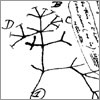

|
|
Evolution happens.
Darwin wasn't the first to suggest the theory of
evolution—that all living things originate from
ancestral forms and that their distinguishable
differences are due to modifications in successive
generations. But no one gave it more thought, or
provided more evidence for it, or more deeply ingrained
the theory into our collective consciousness than
Charles Darwin. Today, researchers using the genetic
techniques of "evo devo" can trace the evolution of the
various kinds of organisms that Darwin fit into his
"tree of life" (here, from an 1837 notebook, his first
such tree). As the geneticist Theodosius Dobzhansky once
wrote, "Nothing in biology makes sense except in the
light of evolution."
|
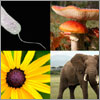

|
|
Evolution happens through natural selection.
Darwin was not content to say that organisms evolve. The
theory of evolution, he wrote, "even if well founded,
would be unsatisfactory until it could be shown
how the innumerable species inhabiting this world
have been modified so as to acquire that perfection of
structure and coadaptation that most justly excites our
admiration" [italics added]. In what has been called
"the greatest idea anyone ever had," Darwin theorized
how those modifications occurred—through a process
he called natural selection, which holds that
individuals within a species that are best suited to
their environment will survive and reproduce more than
those less suited, thereby passing on their more useful
traits and genetic qualities to successive generations.
"Nothing that we have learned in the intervening 175
years," writes paleontologist Niles Eldredge of the time
since Darwin first started formulating his theory, "has
contravened Darwin's basic description of how natural
selection works."
|
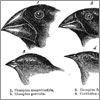

|
|
Evolution happens through natural selection. (continued)
Suitably, one of the most striking examples of natural
selection in action concerns the very Galapagos finches
that Darwin made famous. Since 1973, biologists Peter
and Rosemary Grant, working on the tiny island of Daphne
Major in the Galapagos, have studied a species of finch
called Geospiza fortis (upper right in
illustration, which appeared in Darwin's 1839 book about
his five-year journey aboard the Beagle). After a
drought in 1977 devastated plants bearing small seeds,
more than 1,000 of the 1,200 G. fortis finches on
the island died. The Grants discovered that larger
G. fortis, which could break open larger seeds
than smaller G. fortis could, survived better.
The survivors mated in 1978, and, on average, their
offspring had beaks 4 percent larger than those of the
previous generation. Following another drought in 2003,
G. fortis with smaller beaks survived better, in
part because of stiff competition for bigger seeds after
a larger finch species, G. magnirostris, settled
the island. Between 2003 and 2005, the Grants found,
G. fortis beaks shrank by 5 percent.
|


|
|
Evolution by natural selection must have a
mechanism.
Darwin knew in his heart that evolution by natural
selection happened, but he didn't know how. In
fact, he proposed a mechanism of heredity that proved to
be dead wrong, something he called pangenesis.
Ironically, the actual mechanism of
heredity—genetics—was revealed in Darwin's
lifetime, though he never knew it. Working with pea
plants, the Austrian priest Gregor Mendel discovered the
fundamental laws of genetics in 1865. But Mendel's work
was neglected until 1900, and it wasn't until the 1940s
that scientists identified DNA as the genetic material
(here, Francis Crick's first sketch of DNA's double
helix structure). Today, the clear focus of the
revolutions now under way in genetics, medicine, and
other fields is on the genomes of living organisms.
|


|
|
The mechanism—whatever it is—is natural,
not supernatural.
Darwin held off on publishing his theory for 20 years,
until forced to by fellow naturalist Alfred Russel
Wallace, who had independently come up with the same
idea. One of the reasons for Darwin's delay was he knew
what a shock his theory would represent to Christians,
including his beloved wife Emma, who believed that God
had created all living things, whole and independent of
all others. Darwin didn't hold this view. His friend,
the biologist T. H. Huxley, agreed. "As a natural
process of the same character as the development of a
tree from its seed, or of a fowl from its egg," Huxley
wrote, "evolution excludes creation and all other kinds
of supernatural intervention." Of course, many people
around the world still believe in a divine instrument of
creation.
|
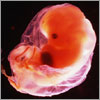

|
|
Embryology is "the strongest single class of facts in
favor of change of forms."
Darwin considered the process that a fertilized egg goes
through on the way to becoming a multibillion-celled
adult as crucial to understanding how basic anatomical
parts of both animals and plants change over
evolutionary time. The new science of evolutionary
developmental biology, "evo devo," is revealing the
truth behind Darwin's assertion quoted above. Until
recently, scientists could say that forms do change, but
they couldn't say exactly how, because they
didn't know which genes were essential for the
development of any organism. They now know that,
remarkable as it may seem, all organisms on Earth, from
microbes to man (a human embryo is seen here), share a
common "tool kit" of so-called master genes, which
govern how bodies and body parts form. When and which of
these genes are turned "on" or "off" during the
embryonic stage determines how each organism is built.
|


|
|
Sexual selection also drives evolution.
The peacock posed an enigma to Darwin. How could its
extravagant tail feathers have come about? How do they
aid in the "survival of the fittest" (a phrase coined by
the philosopher Herbert Spencer)? Darwin proposed an
answer in his book Descent of Man, in which he
introduced a novel concept—sexual selection, the
critical role that the opposite sex plays in the
evolution of traits. Over time, Darwin believed, peahen
choices about which peacocks constituted the finest
mates could have led to the males' absurdly ostentatious
tails. In the 1990s, biologist Marion Petrie of the
University of Newcastle-upon-Tyne showed Darwin's hunch
to be true. On average, peacocks have 150 "eyes" on
their tails. By clipping off just a few of those eyes,
Petrie found he could significantly reduce a male's
chances of mating; males with fewer than 130 eyes rarely
mated at all. Petrie reasoned that the healthier a
peacock was, the more he could invest in the production
of eyes—something that peahens clearly saw for
themselves.
|
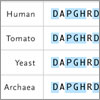

|
|
All animals, including humans, descend from a common
ancestor.
Darwin knew the idea that man was just another animal
would go over like a lead balloon in Victorian society.
But in the Origin of Species, he was unequivocal
on this notion, writing that "I should infer from
analogy that probably all the organic beings which have
ever lived on this earth have descended from one
primordial form, into which life was first breathed."
Evidence supporting this view has accumulated ever
since, with arguably the strongest support coming from
evo devo. Scientists comparing the genomes of members of
the three domains of life—archaea, bacteria, and
the eukaryotes (animals, plants, fungi, and
protists)—have discovered about 500 genes that all
living things share. These "immortal" genes have
survived essentially unchanged for over two billion
years (including the portion of a protein's sequence
seen here, with shared amino acids indicated by
shading). Says Brown's Ken Miller: "Despite the
extraordinary diversity of life, all living organisms
share a nearly identical set of essential genes,
reflecting their evolutionary development from a common
ancestor."
|
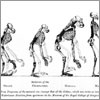

|
|
Humans evolved from an ape-like ancestor.
Fearing that many of his contemporaries would be deeply
offended if he suggested that humans and apes share a
common ancestor, Darwin barely touched on human
evolution in the 1859 Origin of Species. But by
the 1871 Descent of Man, he was ready, stating
baldly that "man is descended from a hairy, tailed
quadruped, probably arboreal in its habits." He also
maintained that the difference between the mind of man
and that of a chimpanzee or gorilla is a matter of
degree, not of kind. Summing up, Darwin wrote, "We must
… acknowledge, as it seems to me, that man with
all his noble qualities … still bears in his
bodily frame the indelible stamp of his lowly origin."
Today, many a schoolchild can cite the figure perhaps
most often called forth in support of this
view—namely, that we share almost 99 percent of
our DNA with our closest living relative, the
chimpanzee. (The illustration shown here appeared in T.
H. Huxley's 1863 book Man's Place in Nature. All
skeletons are to scale except the gibbon, which is shown
twice natural size.)
|


|
|
Modern humans arose in Africa.
In Darwin's day, virtually no fossils of early humans
were known—one of the few was Neanderthal Man,
discovered in Germany's Neander Valley in 1856—nor
could anyone date them reliably. But noticing our close
anatomical relationship to chimps and gorillas, Darwin
surmised that Homo sapiens had evolved in Africa.
In his customary careful way, he wrote, "It is somewhat
more probable that our early progenitors lived on the
African continent than elsewhere." Today, the fossil
known as Lucy is only the most famous of numerous
fossils of human and human-like species whose age and
other particulars confirm the notion that modern humans
first came into existence in Africa. Here, a 1999
evolutionary tree based on DNA shows how the five great
apes, including us, arose from a common ancestor. Branch
length indicates how far the genes of each population
have diverged from those of near relatives.
|


|
|
The Earth is at least several hundred million years
old.
In 1658, based on his reading of the Bible and on
historical records, the Irish clergyman James Ussher
declared that God had created the Earth on October 22,
4004 B.C. Geologists of Darwin's day begged to differ,
arguing for a far older Earth. Darwin, knowing that
evolution required vastly more time than just six
millennia, concurred. In the first edition of the
Origin of Species, he estimated our planet to be
at least several hundred million years old. In fact, as
is well known today, it is far more primeval. In the
1900s, after Marie and Pierre Curie discovered
radioactivity, physicists learned how to use the
half-life of uranium and other radioactive elements to
estimate the age of rocks. The oldest minerals found on
Earth are about 4.1 to 4.2 billion years old, indicating
our planet is at least that old. But meteorites, which
scientists believe formed at the same time as the
planets and which, unlike the Earth, are not
geologically active and therefore retain evidence of
their formation, date even further back. Using several
different dating methods on dozens of different kinds of
meteorites, scientists have, in instance after instance,
come up with an age of roughly 4.5 billion
years—the current widely accepted estimate of our
planet's age.
|
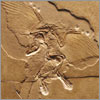

|
|
Gaps in the fossil record will be filled in with key
transitional fossils.
In his notebooks, Darwin worried about the many gaps in
the fossil record that then existed, "like pages torn
from a book." Perhaps the most glaring was the complete
lack of fossils before the Cambrian Period (544-510
million years ago). "To the question why do we not find
rich fossiliferous deposits belonging to these assumed
earliest periods before the Cambrian system, I can give
no satisfactory answer," he wrote. If his theory of
evolution was right, he knew such gaps would eventually
be filled in. Only in the past half century have
paleontologists unearthed fossils from the Precambrian,
and it's a huge and ever-growing trove, with the oldest
fossils dating to about 3.5 billion years ago. Moreover,
they continue to unearth key fossils that bridge those
gaps Darwin bemoaned, including Archaeopteryx,
shown here. To see a range of such transitional fossils,
go to
Fossil Evidence.
|


|
|
An insect with a foot-long tongue must exist to
pollinate this orchid.
Not all of Darwin's conjectures were so broad in scope
or so earth-shaking; some were simple predictions. Take
the case of this species of orchid,
Angraecum sesquipedale, from Madagascar. When
Darwin saw this orchid in 1862, he, like anyone who saw
it, was astonished by the length of its spur, which can
reach over a foot in length. (See long, slim tube in
photo.) "Astounding," he wrote. "What insect could suck
it?" For some as-yet unknown insect must, he insisted,
and it had to have a foot-long tongue to get at the
plant's nectar, which pools at the very base of the
spur. Entomologists of his day were skeptical, for no
such creature had ever turned up. But several decades
after Darwin's death in 1882, scientists discovered a
giant hawk moth in Madagascar, and it lapped the
orchid's nectar with, yes, a foot-long tongue. The moth
was named Xanthopan morganii praedicta in honor
of his prediction. Once again, Darwin was right.

|
Selected sources for this article
|


We recommend you visit the
interactive version. The text to the left is provided for printing purposes.
|















